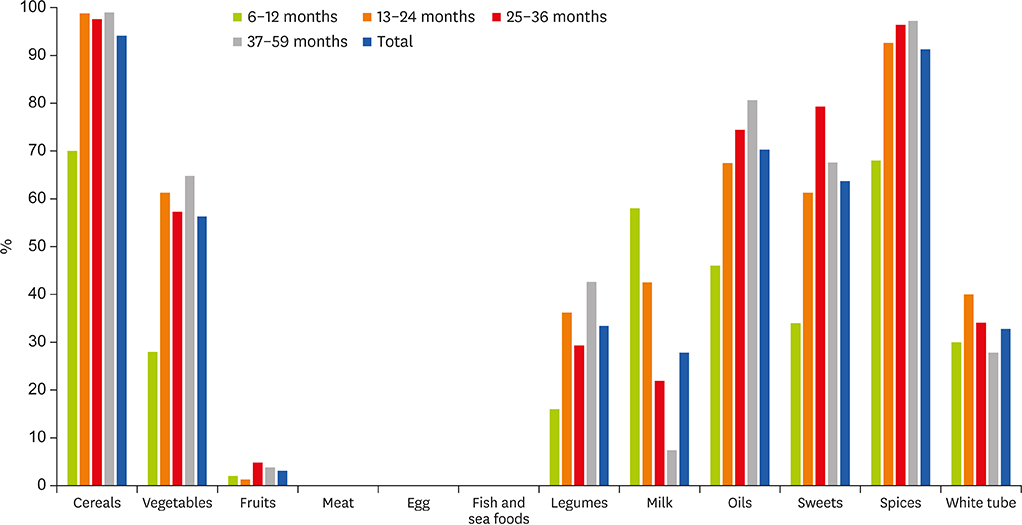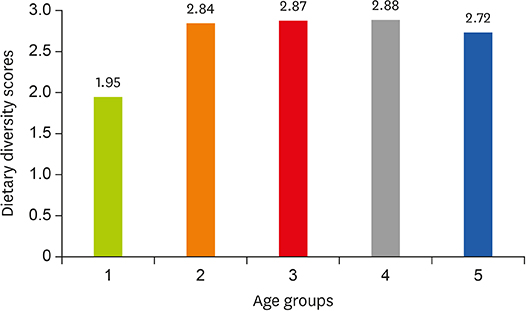Clin Nutr Res.
2019 Oct;8(4):307-317. 10.7762/cnr.2019.8.4.307.
Dietary Diversity, Social Support and Stunting among Children Aged 6–59 Months in an Internally Displaced Persons Camp in Kayin State, Myanmar
- Affiliations
-
- 1ASEAN Institute for Health Development, Mahidol University, Nakhon Pathom 73170, Thailand. seoah.hon@mahidol.ac.th
- KMID: 2461098
- DOI: http://doi.org/10.7762/cnr.2019.8.4.307
Abstract
- Children living in the internally displaced person (IDP) camp are at higher risk of stunting. This cross-sectional study aimed to assess the prevalence and to identify the associated factors of stunting among children aged 6-59 months at Myaing-Gyi-Ngu IDP camp in Kayin State, Myanmar. According to the World Health Organization Child Growth Standards, children with a height-for-age Z-scores below −2 standard deviation of the reference median (HAZ ≤−2) were classified as stunted. Multiple logistic regression analysis was performed to identify the strong predictors. Prevalence of stunting has been found very high (59.4%). Adjusted model revealed that children living with illiterate mothers (odds ratio [OR], 1.86; 95% confidence interval [CI], 1.07-3.24), being third/later-birth child (OR, 1.88; 95% CI, 1.13-3.14), consuming less than 4 food groups (OR, 4.22; 95% CI, 1.94-9.16), and older age of child (OR, 6.36 for 13-24 months; 95% CI, 2.74-14.74, 7.45 for 25-36 months; 95% CI, 3.21-17.25 and 12.75 for 37-59 months; 95% CI, 5.51-29.52) had higher odds of becoming stunted. The levels of support availability, presumed support and support received of mothers were generally low, but no significant associations were observed. In conclusion, this study showed high prevalence of stunting, but low dietary diversity and social support in the IDP camp. Due to the significant association of dietary diversity scores with stunting, interventions aiming at improving dietary diversity should be taken to reduce the stunting among children in the IDPs camp.
MeSH Terms
Figure
Reference
-
1. United Nations (UN). The sustainable development goals. 2015. cited 2018 October 20. Available from https://sustainabledevelopment.un.org/sdgs.2. United Nations Children's Fund (UNICEF). World Health Organization (WHO). World Bank Group. Levels and trends in child malnutrition: key findings of the 2018 edition. 2018. cited 2018 October 30. Available from https://www.who.int/nutgrowthdb/2018-jme-brochure.pdf?ua=1.3. Chaparro C, Oot L, Sethuraman K. Overview of the nutrition situation in seven countries in Southeast Asia. 2014. cited 2018 October 15. Available from https://www.fantaproject.org/sites/default/files/download/Southeast-Asia-Nutrition-Overview-Apr2014.pdf.4. Ministry of Health and Sports. International Coach Federation. Myanmar demographic and health survey 2015–16. Nay Pyi Taw, Rockville: Ministry of Health and Sports, ICF;2017.5. World Health Organization (WHO). Nutrition Landscape Information System (NLIS) country profile indicators: interpretation guide. 2010. cited 2018 October 8. Available from http://apps.who.int/iris/bitstream/handle/10665/44397/9789241599955_eng.pdf;jsessionid=F652CBE967DF654943B9CA0C0E33425F?sequence=1.6. Ali W, Ayub A, Hussain H. Prevalence and associated risk factors of under nutrition among children aged 6 to 59 months in internally displaced persons of Jalozai Camp, District Nowshera, Khyber Pakhtunkhwa. J Ayub Med Coll Abbottabad. 2015; 27:556–559.7. Myanmar Humanitarian Country Team (United Nations and Partners). 2018 humanitarian needs overview. 2017. cited 2018 November 17. Available from https://reliefweb.int/sites/reliefweb.int/files/resources/2018%20Myanmar%20Humanitarian%20Needs%20Overview.pdf.8. Abdullah AA, Rifat MA, Hasan MT, Manir MZ, Khan MM, Azad F. Infant and young child feeding (IYCF) practices, household food security and nutritional status of under-five children in Cox's Bazar, Bangladesh. Curr Res Nutr Food Sci. 2018; 6:789–797.
Article9. Engle PL, Ricciuti HN. Psychosocial aspects of care and nutrition. Food Nutr Bull. 1995; 16:356–377.
Article10. de B L Carvalhaes MA, D'Aquino Benício MH, Barros AJ. Social support and infant malnutrition: a case-control study in an urban area of Southeastern Brazil. Br J Nutr. 2005; 94:383–389.
Article11. Save the Children. Nutritional anthropometric assessment (based on SMART methodology), children aged 6 to 59 months living in IDP camps, Nam Hkam and May Ja Yang area, Northern Shan and Kachin State – Republic of the Union of Myanmar. 2014. cited 2018 November 15. Available from http://themimu.info/sites/themimu.info/files/documents/Report_SMART_Survey_Kachin_IDP_Camps_SCI_April2014.PDF.12. Crosby R, Noar SM. What is a planning model? An introduction to PRECEDE-PROCEED. J Public Health Dent. 2011; 71:Suppl 1. S7–15.
Article13. Kristen C, Lesley O. Guide to anthropometry: a practical tool for program planners, managers, and implementers. 2018. cited 2018 December 2. Available from https://www.fantaproject.org/sites/default/files/resources/FANTA-Anthropometry-Guide-May2018.pdf.14. World Health Organization (WHO). WHO child growth standards: length/height-for-age, weight-for-age, weight-for-length, weight-for-height and body mass index-for-age: method and development. 2006. cited 2018 December 2. Available from https://www.who.int/childgrowth/standards/Technical_report.pdf.15. Kennedy G, Ballard T, Dop MC. Guidelines for measuring household and individual dietary diversity. 2011. cited 2019 February 9. Available from http://www.fao.org/3/a-i1983e.pdf.16. World Health Organization (WHO). Indicators for assessing infant and young child feeding practices: part 1: definitions: conclusions of a consensus meeting held 6–8 November 2007 in Washington, DC, USA. Geneva: WHO;2008.17. World Health Organization (WHO). Global Health Observatory (GHO) data. 2017. cited 2019 January 25. Available from https://www.who.int/gho/child-malnutrition/en/.18. Hlaing LM, Fahmida U, Htet MK, Utomo B, Firmansyah A. Dietary diversity and nutritional status of children aged 12–23 months from Ayeyawady Region of Myanmar. Myanmar Health Sci Res J. 2017; 29:1–8.19. Rah JH, Akhter N, Semba RD, de Pee S, Bloem MW, Campbell AA, Moench-Pfanner R, Sun K, Badham J, Kraemer K. Low dietary diversity is a predictor of child stunting in rural Bangladesh. Eur J Clin Nutr. 2010; 64:1393–1398.
Article20. Fenske N, Burns J, Hothorn T, Rehfuess EA. Understanding child stunting in India: a comprehensive analysis of socio-economic, nutritional and environmental determinants using additive quantile regression. PLoS One. 2013; 8:e78692.
Article21. Rammohan A, Pritchard B, Dibley M. Home gardens as a predictor of enhanced dietary diversity and food security in rural Myanmar. BMC Public Health. 2019; 19:1145.
Article22. Kumera G, Tsedal E, Ayana M. Dietary diversity and associated factors among children of Orthodox Christian mothers/caregivers during the fasting season in Dejen District, North West Ethiopia. Nutr Metab (Lond). 2018; 15:16.
Article23. Guha S, Mandal NK. A Study on risk factors of under-nutrition of under-five children in an urban area of Malda district, West Bengal. J Compr Health. 2016; 4.24. Wamani H, Tylleskär T, Astrøm AN, Tumwine JK, Peterson S. Mothers' education but not fathers' education, household assets or land ownership is the best predictor of child health inequalities in rural Uganda. Int J Equity Health. 2004; 3:9.
Article25. Abuya BA, Ciera J, Kimani-Murage E. Effect of mother's education on child's nutritional status in the slums of Nairobi. BMC Pediatr. 2012; 12:80.
Article26. Degarege D, Degarege A, Animut A. Undernutrition and associated risk factors among school age children in Addis Ababa, Ethiopia. BMC Public Health. 2015; 15:375.
Article27. Kandala NB, Madungu TP, Emina JB, Nzita KP, Cappuccio FP. Malnutrition among children under the age of five in the Democratic Republic of Congo (DRC): does geographic location matter? BMC Public Health. 2011; 11:261.
Article28. Torlesse H, Cronin AA, Sebayang SK, Nandy R. Determinants of stunting in Indonesian children: evidence from a cross-sectional survey indicate a prominent role for the water, sanitation and hygiene sector in stunting reduction. BMC Public Health. 2016; 16:669.
Article29. Ziaei S, Contreras M, Zelaya Blandón E, Persson LÅ, Hjern A, Ekström EC. Women's autonomy and social support and their associations with infant and young child feeding and nutritional status: community-based survey in rural Nicaragua. Public Health Nutr. 2015; 18:1979–1990.
Article
- Full Text Links
- Actions
-
Cited
- CITED
-
- Close
- Share
- Similar articles
-
- The Effect of the Physical Factors of Parents and Children on Stunting at Birth Among Newborns in Indonesia
- Complementary feeding practices and nutritional status of children 6–23 months old: formative study in Aceh, Indonesia
- A Study of the Social Support Perceived by Children: Physically Handicapped and Non-physically Handicapped
- Association of Social Support and Social Activity with Physical Functioning in Older Persons
- Social Support Network and Gender Difference in Post-hospitalized Stroke Patients



